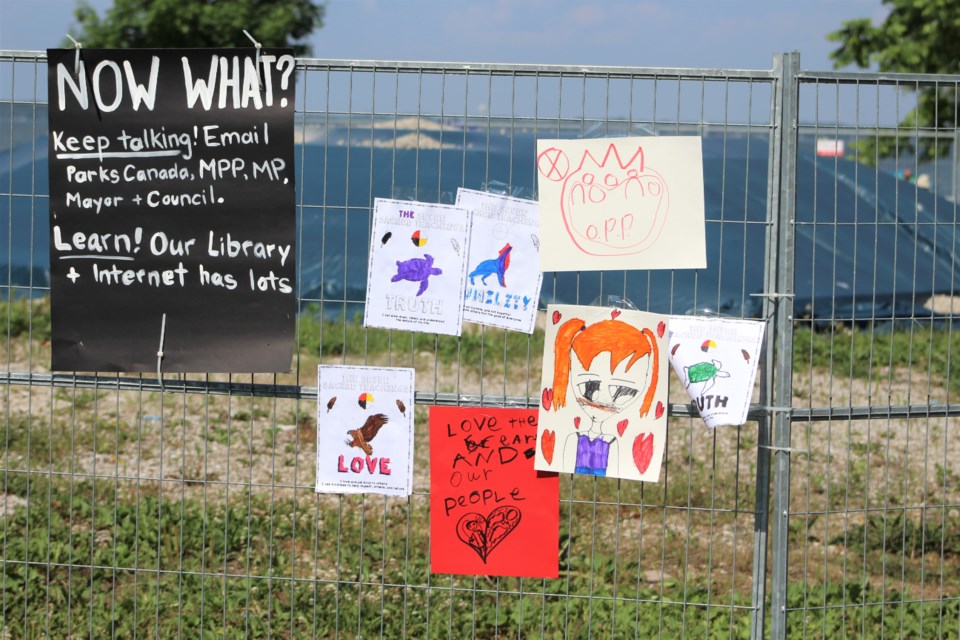News of Parks Canada’s decision to defer the return of the Champlain Monument to Couchiching Beach Park is getting some mixed reactions.
The federal agency announced Thursday the delay was “to allow for additional progress on the implementation of the Samuel de Champlain Monument Working Group recommendations.”
The statue was removed in 2017 for repairs and restoration. Since then, there has been growing opposition to its return.
The working group released a list of recommendations last year, one being “that additional interpretive signage/pieces be developed and created with the participation of First Nations representatives to tell a historically accurate story of Samuel de Champlain and his relationship with First Nations.”
Jeff Monague, an educator and knowledge keeper from Beausoleil First Nation, feels that educational component can be added without the main statue.
“I’d rather see the story being depicted without the monument. You don’t need the monument to that individual,” he said, noting such statues — or even petroglyphs — have not been priorities of Indigenous peoples “because there was no hierarchy.”
Besides, he added, “it’s always been kind of strange to try to understand why and how a predominantly English community would be so bent on honouring the father of New France.”
He is hopeful the updated monument will accurately tell the history from the Indigenous perspective, since reconciliation includes a need to acknowledge “past harms” and indicate how they will be addressed going forward.
Miranda Minassian, who organized a rally July 1 to protest the monument’s return, is “happy that the statue isn’t going back up this summer,” but she still doesn’t want to see it back.
“I don’t think a deferral is the leadership that either First Nations or people of colour were looking for. We were looking for more leadership from our elected officials,” she said. “A deferral is just a deferral of our elected leaders taking a stance.”
Returning the monument, Minassian added, would be “a massive minimization of the eruption of minorities screaming to be heard.”
“That is a monument to genocide. It doesn’t allow people to move forward,” she said.
She did credit Simcoe North MP Bruce Stanton for raising the issue with Parks Canada. After attending the July 1 demonstration, Stanton said he contacted the office of the ministry responsible for Parks Canada to ask if it was “a good idea” to return the monument at this time.
As a result, Stanton said, Parks Canada reached out to members of the working group, including representatives from Rama First Nation, the Huron-Wendat Nation and the City of Orillia, to discuss the matter.
He said the goal is to not deviate from the initial recommendations, other than the call to have the Champlain figure itself returned “immediately.” It will give the working group more time to discuss the additional components.
“It’s important to communicate to the community and to the people who are opposed to this historic monument that they understand that the individual monument coming back is just part of the process of telling the Indigenous story as well,” he said. “There is some misunderstanding about this monument and what it represents. It’s important that the community have a good, full understanding.”
Mayor Steve Clarke, a member of the working group, is in favour of the monument being returned and is also supportive of additional components that explain the Indigenous perspective and history.
The placement of the Indigenous people on the original monument, with them situated below Champlain and a Jesuit priest, is “a problem,” he said.
“There are parts of the history that need to be told to the community and I’m excited to be a part of that,” Clarke said.
He is asking people to be patient as the working group works toward a consensus on the additional components.
“In the end, what really matters is we get the whole story, stretching back 5,000 years,” he said.
Not returning the statue at all is not the answer, he added.
“An empty field doesn’t find common ground and it doesn’t provide an accurate education. We now have a chance to make that right,” he said.
It’s not yet known when the working group will convene, but Clarke said members are hoping to meet “imminently.”
